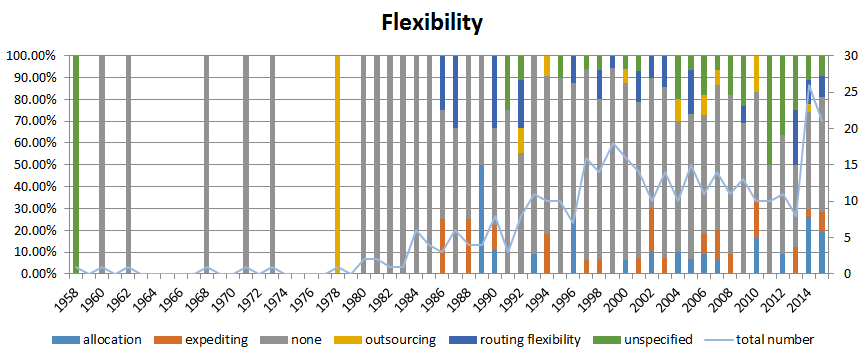MEIO – Multi-Echelon Inventory Optimization
Project Leader: Prof. Dr. Jörg Rambau
Contact: Prof. Dr. Jörg Rambau
Project start: 2012/05/06
Project team:
- Prof. Dr. Jörg Rambau
External partners:
- Prof. Dr. A.G. de Kok, TU Eindhoven, The Netherlands
- Prof. Dr. Stefan Minner, TU München
- Dr. A.A.J. Lefeber, TU Eindhoven, The Netherlands
- Dr. Marco Laumanns, Switzerland
- Dr. Konrad Schade, Volkswagen AG, Baunatal
- Christopher Grob, Beiersdorf AG, Hamburg
Project description:
APPLICATION BACKGROUND

One important aspect of Supply Chain Management is how to distribute stock in a network of inventories. A prominent way of organizing replenishment orders is by the specification of safety stocks (the inventory level up to which we replenish) and reorder points (the inventory level at which an order is triggered). Classically, each stock point would optimize its safety stock and reorder points individually. The result is the famous bull-whip effect, i.e., the demand variablility increases drastically from end customer stock points all the way up to the top central warehouses. Multi-Echelon Inventory Optimization seeks to find coordinated replenishment policies in an inventory network that yield a satisfying balance between capital investment in inventories, service qualitiy for the customer, and operational costs like production, transport, or emergency measures. In order to be able to compare various approaches and to judge the practical implications, the Lehrstuhl Wirtschaftsmathematik (Prof. Dr. Jörg Rambau) cooperates in this project with Prof. Dr. Stefan Minner (TU München), Prof. Dr. A.G. de Kok (TU Eindhoven, The Netherlands), Dr. A.A.F. Lefeber (TU Eindhoven, The Netherlands), Dr. Marco Laumanns (Switzerland), Dr. Konrad Schade (Volkswagen AG, Baunatal), and Christopher Grob (Volkswagen AG, Baunatal).
CONTRIBUTION TO THE MISSION OF MODUS
The formalization of inventory problems is classically based on Markov Decisions Problems (MDP). The states are typically represented by the inventory levels and pipeline stocks, occasionally plus additional information to formally make the model Markov (i.e., independent of the historical development). Since in large networks, the curse of dimensionality prohibits an exact numerical solution of MDP models, other means have been developed. In this project, among other approaches, the Guaranteed Service Model (GSM) is developped further. The classical GSM is designed to cope with a bounded demand only. This bounded demand is not given as an probability distribution over demand quantities, but by a demand bound function mapping any positive duration to the maximal demand ever presented in any time interval of this duration. The decisions of the GSM are guaranteed service times. These are the maximal times it takes a stock point to start the delivery of a replenishment order issued by a downstream stock point. The receiving stock point then only needs to add all additional (constant by assumption) delays (like transportation delays) to this time, resulting in a reliable receiving time of the replenishment order. Given these delays one can use the demand bound function to calculate the necessary stock leven in order to avoid stock-outs completely. The short-comings of the GSM are its central assumptions of bounded demand and constant delays. In this project we extend the GSM by a stochastic component to the Stochastic GSM (SGSM), which can be formulated as a two-stage stochastic mixed-integer linear program with recourse. The SGSM considers multiple demand scenarios. Demands can be satisfied either by own inventory, by outsouring, or by expediting operations. For the latter two, additional cost parameters are needed. The SGSM balances inventory capital investments with operational costs for emergency measures in the case of stock-outs.
RESULTS
Extensive simulations on the spare-part distribution system at Volkswagen AG have shown a very promising results where SGSM policies outperformed GSM policies and policies from completely different approaches by a large margin. A theoretical relationship between optimal GSM and optimal SGSM policies has been established: Under mild assumptions, each optimal GSM policy is an optimal SGSM policy for certain suitable SGSM cost parameters, but in general not vice versa. The main obstacle for putting the SGSM into practice is the need for many extra cost coefficients. Thus, an investigation about the sensitivity of the resulting policies on these cost coefficients is promising.
A new line of research concerns the correctness of the demand propagation in GSM models. Whenever outsourcing is an option, the internal demands are endogeneous. All current models in the GSM context ingnore this. In a master's thesis by Löhnert and in a constribution for MATHMOD 2018 we have shown that, first, the problem is relevant (up to 40% mis-assessment in the cost) and, second, that there are approaches that close the gap by modeling the demand propagation explicitly. The continuation of this activity will be shifted to a separate project supported by the German Science Foundation starting soon.
The current interest focusses on a simulation framework in which various models and policies can be compared under identical assumptions. To this end, an all new generic formal model is developped for the representation of supply chain networks.
SERVICE (NEW: BIBTEX FILE UPDATED TO CONTAIN PAPERS FROM 2017!)
In our recent survey on stochastic multi-echelon inventory management (under review) we collected a bibtex data base of the relevant literature and added a typology classification to each entry. As a service to the research community we make this bibtex data base available here for free scientific use. If you are using the free reference manager JabRef, you may want to import our JabRef preferences file for easier access to the classification data from inside JabRef. The rules are as follows:
- We are not aware of any dangerous consequences of using the bibtex data base. Anyway: The file comes with ABSOLUTELY NO WARRANTY. USE IT AT YOUR OWN RISK! We are not responsible for any loss or damage the bibtex data base may cause.
- Any non-academic use of the bibtex data base requires written permission of the authors.
- If you use the bibtex file and/or the classification therein, please, cite our survey, currently as
Ton de Kok, Christopher Grob, Marco Laumanns, Stefan Minner, Jörg Rambau, Konrad Schade:
A typology and literature review on stochastic multi-echelon inventory models,
European Journal of Operational Research, Volume 269, Issue 3, 2018, Pages 955–983 - If you think there is an error or a mis-classification in an entry, please notify via email the head of this project.
- If you want to contribute to the bibtex data base with a new classified entry, please, send a bibtex entry with full classification (analogous to what you see in the current file) via email to the head of this project. The team will then review your suggestion and update the data base accordingly. Legal notice: we do not guarantee that your item will appear, and we do not guarantee that it will appear unedited.
Thanks in advance for your valuable support!

